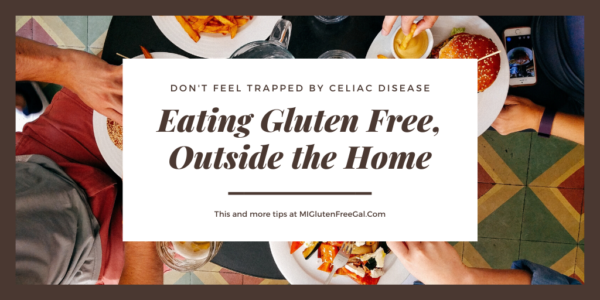Eating Out, Gluten Free: Restaurants and More
As an Amazon Associate and member of other affiliate programs, I earn from qualifying purchases.
When newly diagnosed with Celiac Disease, your first priority becomes making your home a safe place to eat. But what about outside your home? Here are tips on eating out, both at restaurants and other locations.

While dining at restaurants is relaxing for many, doing so with dietary restrictions can be daunting. When you live in a household with multiple food intolerances, it requires a long list of questions. Sometimes it feels like you’re interrogating someone! However, don’t let these concerns stop you from eating outside the comfort of your home.
Tips on Eating Gluten Free at Restaurants
Let’s face it.There are times that the last thing you want to do is cook. You long for the days of picking up a Hot-N-Ready pizza from Little Casear’s and no dirty dishes in the sink. (Or is that just me?) Unfortunately your genetic makeup has decided that isn’t possible. We need to not only stay away from foods that contain gluten, but also be wary of how things are prepared. Here are my tips for a successful dining out experience.

1. Timing Is Everything
It’s always best to call a restaurant before eating out. Don’t call 5 minutes before you walk out the door. Call during their slowest time, usually between 2 and 4 pm. Ask to speak with the head chef or whoever is primarily in charge of the kitchen. Ask if they have a gluten free menu, and how they handle gluten free orders.
Also ask how they prevent cross-contact. Cross-contact, as it pertains to food allergies, happens when one food protein comes in contact with another. For example, when your gluten-free pizza crust gets prepared on top of regular wheat-based flour, it has now been cross-contacted and that pizza is no longer Celiac-safe. Here are some questions to ask your server.

2. Specific Questions to Ask
First, always remember that kindness goes a long way. So often it can feel like an act of interrogation when asking about food prep. The goal is to be Verbal Kint, not Keyser Söze. Meanwhile, there are so many places where gluten can sneak into a dinner. Here are just a few of my top questions.
- Do that have a dedicated space where they prepare all gluten-free food?
- Do they have a dedicated fryer?
- Do they prepare their gluten-free pasta with fresh water and in a completely clean pot?
- Do they have a dedicated griddle for their pancakes, or waffle iron?
This short list is just a beginning. Follow this link for a list of dining questions to ask, broken down by menu type.
3. Walk Away
And remember, if you feel unsafe eating at a restaurant, you have every right to walk out. I’ve had to do it once myself, after they managed to mess up not only my meal, but my husband’s as well. You are the consumer and your health is in your hands.

4. Resources for Finding Gluten Free Restaurants
Restaurant Phone Apps
My favorite gluten-free dining website and smartphone app is Find Me Gluten Free. The app uses the GPS location on your smartphone and alerts you to restaurants in the area that (may) have safe gluten free options. (You can also search by address.) There are designations for dedicated gluten free restaurant and bakeries, as well.
This is a user supported system, meaning that restaurant listings and reviews are placed on the site by consumers. I tell people to ALWAYS read reviews of any restaurant that you are considering. There might be issues listed in the comments. This app should be a starting spot for research. You must still follow up with food prep questions.
You can also check out my list of Michigan Gluten Free Dining Options. I wrote a Chicago list, too!
Gluten Free Kitchen Training
Some organizations work to make this situation easier. MenuTrinfo and Gluten Intolerance Group both implement restaurant training programs. Seeing their certification seals and logos is a huge help. The Melting Pot is one such restaurant that has gone thru training.
Some hospitals undergo training, which is absolutely necessary. Believe it or not, I feel that hospitals are the worst in accommodating Celiac Disease. Therefore, I ALWAYS recommend you always have another person present to speak up for your food needs. Also see this post from Amy Keller, RD about eating gluten free in the hospital.
Eating Out at Someone Else’s House
What about dining in someone else’s home? All the same cross-contact issues still apply. Always graciously talk to the hostess ahead of time and explain your needs. Grilling out? Ask if your burger can be cooked on tinfoil. Offer to bring dishes. Even offer to prep food at their home. Always remember BYOB- Bring Your Own Bun.
If you feel unsure about dining any place outside of your home, we have a mantra – “When In Doubt, Go Without.” Bring snacks in your purse or briefcase, or eat prior to going. Stay a limited amount of time and pick up something on the way out. While not being able to eat with others can be stressful, it’s helpful to try to find ways to focus on who you’re with instead of what you’re (not) eating.

Children Eating Gluten Free Outside of the Home
A word about kiddos and being gluten-free at school. Helping a child remain gluten-free during the school day involves so much more than just lunch. There are snack times, classroom parties, crafts (did you know that Playdough contains wheat?) and so much more.
It’s important to have a good conversation, every year, with your child’s teacher and school principal. I HIGHLY suggest that each child has a 504 plan in place. Read more about dealing with this issue on Beyond Celiac’s site. You can find other school related resources on the Celiac Mama website, especially at Back to School time.
Other Gluten Free and Celiac Disease Resources
With Celiac Disease, we never stop learning. New research is always out there, new books are always written and companies are always innovating. Whether you’re new to Celiac Disease or you’re a veteran like me, there are always new helps along the way. Here are links to some of my favorites.
- Books for Adults to Read – This is my list of 5 educational books adults should read
- Books for Children to Read – These 10 books are written for children who live gluten free
- Cookbooks to Buy – Get started cooking gluten free, and other food allergies as well
- Phone Apps – Three phone apps I recommend, and the one (type) I don’t.
- National Research & Support Organizations – We have lots of people advocating for us!

Gluten Free Bloggers
I would be remiss if I didn’t mention my fellow bloggers. As a reminder, the majority of us are not medical professionals. However, we share our experiences in hopes that we can make your journey easier. Some bloggers only focus on food. Other share about travel, or up to date gluten free news. Find an extensive list, by state, in my USA GF Bloggers post.
Even though not solely focused on gluten-free eating, I rely on the websites The Kitchn and All Recipes.com. The Kitchen (notice there’s no “e” in the title) has many great posts about basic cooking skills. All Recipes allows you to search for recipes by excluding ingredients that you don’t want in your meal.
What other resources do you use for eating out? What “helps” have made your gluten free journey easier? Leave me a note in the comments below!
This post is fourth in a series for those newly diagnosed with Celiac Disease. My first, Why Celiac Disease Makes Food Your Enemy, explains what Celiac Disease is and isn’t. The second, “Gluten Free Defined,” explains what foods do and do not contain gluten. The third installment, Follow Up Care, reviews annual exams that should be perfroemd to keep your health in check. I hope you find them helpful!

One Comment